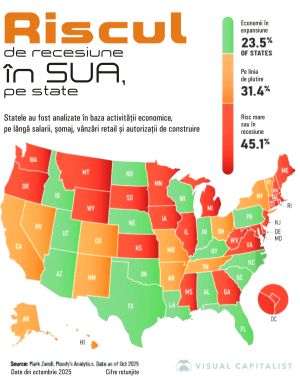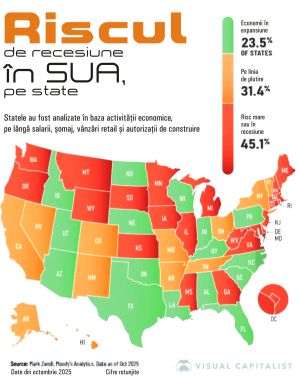The heated debates around the law of giving in payment of the ban collaterals have brought to the attention of the public a number of arguments which were far too underexplained by those that used them.
One of them, perhaps the most important, concerns the negative effect of the law on the holders of bank deposits.
They will be put in a situation where they will be paid their interest and principal in "bricks and double-layer windows", as representatives of the banking system, and particularly the officials of the NBR have repeatedly said.
The head of the Oversight Division of the NBR, Nicolae Cinteză, warned that, with the depositors' money being used to grant the loans, the law of giving in payment threatens the population's savings.
But how have the population's available cash deposited with banks increased miraculously, when the median income in Romania has advanced and is advancing at a snail's pace? Doesn't another explanation exist for the growth of the deposits in the banking system?
In fact, it does exist and it has even been presented at a level that allows its comprehension by those with a modicum of financial education by the Bank of England, in a two part document published in the first quarterly report of 2014. The two parts of the Bank of England document are found in the electronic archive of the BURSA newspaper, attached to the articles "The understanding of the nature of money is more important than the understanding of financial products", published in the print issues of April 28th 2014 and May 6th, 2014.
"The biggest portion of modern money in a modern economy is found in the form of bank deposits, deposits which are created by the commercial banks themselves", the first part states, because "banks do not act as simple intermediaries, by granting loans out of their deposits set up by those that save, nor do they "multiply" the money from commercial banks to create new loans and deposits".
In the second part of the document (author's note: "The creation of money in the modern economy", authors Michael McLeay, Amar Radia and Ryland Thomas, the Monetary Analysis Department of the Bank of England) stresses the fact that "instead of creating deposits out of the household savings, which they would then use to grant loans, it is bank lending that creates deposits".
The economists of the Bank of England also dispel another erroneous conception, which is present in every manual of Economics, that "the central bank determines the volume of loans and deposits in an economy, by controlling the quantity of money it issues", based on the theory of the "money multiplier".
Furthermore, "the reserves do not represent mandatory restrictions on lending, and the central bank does not set the volume of the available reserves", because "the relationship between reserves and loans usually operates in reverse compared to the way it is described in manuals". Under these circumstances, "the banks decide the volume of the loans they want to grant, depending on the opportunities available", opportunities which depend on the interest rate set by the central bank.
Of course, in the case of loans denominated in Euros or Swiss Francs, the interest rates are set by the ECB or the Bank of Switzerland, but the commercial banks should, at least theoretically, know the nature of the risk that they are subjecting their customers to and warn them about it.
All of these lending decisions determine "the volume of loans created in the banking system", as shown by the economists of the Bank of England.
Now, we can go back to the situation in our banking system. According to data from the NBR, the bank deposits of the population have increased over five times between January 2005 and September 2015, while the median gross salary has increased 2.7 times and the median salary has increased 2.5 times over the same interval.
Where does that increase in deposits come from, when it is not supported by the revenues of the population? Shouldn't there be an explanation on behalf of the NBR, in the name of increasing the degree of financial education?
We should not forget that pensioners, out of their beggarly incomes, do manage to save, however. But where do their pensions come from, when the deficit of the pension fund is growing every year? From government loans, which receive a preferential treatment in the banks' balance sheets. For the government bonds "bought" by banks, financial institutions don't need to have the necessary capital to cover the risks, because the risk weight of those assets is zero, according to the European regulations.
Unfortunately, "the financial engineering tricks" can not change the economic nature of pension payments: they are also loans that get "transformed" into deposits.
"The buying and selling of government bonds by banks is a very important way for the acquisitions or sales of existing assets determine the creation or the destruction of money", the document of the bank of England further states.
If we go beyond the comparison between the growth of bank deposits and the median salary, at the household level, the divergence takes on a whole new size, especially when taking into account the dynamics of the difference between the revenues and expenses of households and the growth of deposits.
Data from the National Statistics Institute (INS) shows that the revenues of the population available for saving have dropped nearly 7% compared to 2008, while bank deposits had increased over 66% at the end of last year. How is that possible? Where is the "money" coming from?
This is the context in which BRD claims that the law of giving in payment "will assault the structural elements of the economy, destroying the value of the properties and impoverishing the whole population", as stated in a communiqué published on the BURSA website.
Unfortunately, the law of giving in payment of bank collaterals to extinguish debts will not "assault the structural elements of the economy", because they have already been seriously affected by the growth in lending in the last half of the past decade.
Now all that is left is the urgent separation of the hopes for development, from the increase in lending and the move to the healthy accumulation of capital.




























































